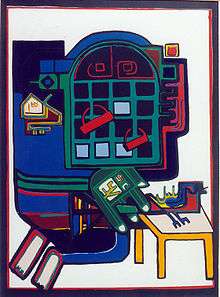Parviz Tanavoli
| Parviz Tanavoli | |
|---|---|
 | |
| Born |
Parviz Tanavoli 23 March 1937 Tehran, Iran |
| Nationality | Iranian |
| Education |
Tehran School of Fine Arts Brera Academy |
| Known for | Sculpture and Painting |
| Notable work |
The Wall (Oh Persepolis) Heech |
| Movement | Saqqakhaneh |
| Patron(s) | Farah Pahlavi |
Parviz Tanavoli (born 23 March 1937 in Tehran) is an Iranian sculptor, painter, scholar and art collector. He has lived in Vancouver, Canada since 1989.
Tanavoli's work has been auctioned around the world leading to overall sales of over $6.7 million, making him the most expensive living Iranian artist.[1]
Academic career
Upon graduating from the Brera Academy of Milan in 1959, Tanavoli taught sculpture for three years at the Minneapolis College of Art and Design. He then returned to Iran and assumed the directorship of the sculpture department at the University of Tehran, a position he held for 18 years until 1979, when he retired from his teaching duties.
Exhibitions

Since 1989 Tanavoli has lived and worked in Vancouver. His latest solo exhibition was a retrospective held in 2003 at the Tehran Museum of Contemporary Art. Prior to that he had held solo exhibitions in Austria, Italy, Germany, United States and Britain. Tanavoli has been in group exhibitions internationally. His work has been displayed at the British Museum, the Grey Art Gallery, New York University, the Isfahan City Center, Nelson Rockefeller Collection, New York, Olympic Park, Seoul, South Korea, the Royal Museum of Jordan, the Museum of Modern Art, Vienna, Museum of Modern Art, New York, Walker Art Center, Minneapolis, Hamline University, St. Paul[2] and Shiraz University, Iran.
Influences
He belongs to Saqqakhana group of artists who, according to the scholar Karim Emami, share a common popular aesthetic. He has been influenced heavily by his country's history and culture and traditions, (he was once cultural advisor to the Queen of Iran) and has always been fascinated with locksmithing.
Politics and art
In 2005, he created a small piece of sculpture called Heech in a Cage to protest the conditions of the American-held prisoners at Guantanamo Bay detainment camp and in 2006 began work on his piece to honour the victims of the Israeli-Lebanon war.
A day before Tanavoli was due to speak at the British Museum, authorities in Iran confiscated his passport, preventing him from leaving the country. By phone from Teheran, Tanavoli explained that "I have not done anything wrong. I spent the whole day at the passport office but no one told me anything, nor did anyone at the airport. I’m not a political person, I’m merely an artist."[3]
Portrayal in film
The documentary film "Parviz Tanavoli: Poetry in Bronze",[4] released in 2015 tells the remarkable story of Tanavoli's journey of creation that began in Iran in the 1950's and has spanned three continents over more than half a century. Directed by Terrence Turner and produced by Timothy Turner and Tandis Tanavoli, the documentary features exclusive interviews with Tanavoli and leading figures in the international art world who illuminate the emergence and rise of this extraordinary artist who continues to this day to return to Iran from his adopted home in Canada to teach young, aspiring artists.
Bibliography
Tanavoli has written dozens of publications, dating back over three decades. Among these are:
- The Afshars, London (in press),
- Gabbeh: Art Underfoot, Tehran (2004),
- Tribal and Rustic Weaves from Varamin, Tehran (2003),
- Persian Flat-Weaves, London. (2002),
- Horse and Camel Trappings from Tribal Iran, Tehran (1998)
- Sofreh of Kamo, Tehran (1996),
- Kings, Heroes and Lovers, London (1994),
- Shahsavan: Iranian Rugs and Textiles, New York, Switzerland (1985),
- Locks from Iran, Washington DC (1977).
- A video clip about Locks from Iran
References
- ↑ http://www.artomorrow.com/eng/index.asp?page=49&id=206
- ↑ http://www.hamline.edu/about/virtual-tour/heech.html
- ↑ theguardian.com July 2, 2016
- ↑ Poetry In Bronze